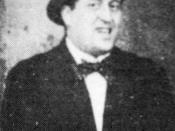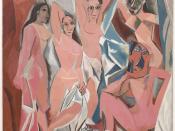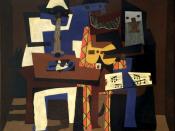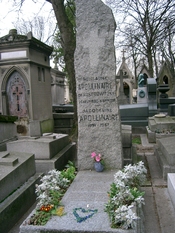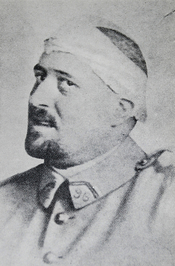The First World War brought about a radical change in the way people viewed society. It evoked the death of passion and fantasy, which were previously associated with the ideas of war. Young men no longer dreamed of riding off into battle. Mothers no longer imagined the heroic glory of their sons in war. The result of this was an outpouring of artistic expression that broke all the rules of style at the time. This form of art, known as cubism, was a revolt against earlier forms of expression. It strayed from contemporary elements, such as the sensual appeal of color and texture, great emotional charge, and the portrayal of dramatic movement. The essence of cubism was a focus on abstract structure. This was done by presenting several aspects of the same object simultaneously, and by fragmenting the form of depicted objects. One of the leading artistic minds in this revolution was Guillaume Apollinaire. Although the most famous examples of cubism are represented in the paintings of his good friend, Pablo Picasso, Apollinaire created this form of art in the form of poetry. It is no surprise that his experiences as a French officer in World War I are apparent in his works, not only in subject, but style as well. In his poem, "Shadow," Apollinaire illustrates the central elements of cubism. Here, the influence of war is present in the personification of the speaker's own memories extended in abstract metaphor throughout the poem. The speaker captures the essence of this in the phrase, "Multiple shadows." The auditor of the poem is the speaker's own personified memories, which seem to provoke different emotions in the speaker. There is a sense of sadness as well as appreciation toward these memories. The word multiple gives the implication of more than one meaning. It indicates the numerous aspects of memories present in the speaker's mind. This could quite possibly reflect the ambiguity and insanity of the Great War, which the writer must undoubtedly have experienced. The inconsistency of the speaker's memories parallel the uncertainty and vague multiplicity of war. Apollinaire emphasizes the feeling of confusion by giving multiple connotations to a single idea. With this in mind, the reader can gain a deeper understanding of how the First World War influenced cubistic expression.
While vague and ambiguous, the memories of fallen comrades blur into clarity in the speaker's mind. Just as a mass of individuals can cast but a single shadow, memories can fade into a single thought. The dark silhouette of a shadow does not distinguish individuality in the components of a group. A shadow is a reflected image from which one cannot hide - an inseparable companion or follower. Just as a man cannot escape his own shadow, he cannot avoid the persistence of his memory. In the poem, the speaker recognizes the continuous presence of his dark memories. As the remembrance of his companions fades, it is strengthened in a single ever-present memory.
The cubist quality of presenting several aspects of an idea to create a single image predominates throughout the poem. It displays the influence of war, and reflects the attitude of society at the time. The seemingly irrelevant and confusing use of metaphor allows Appolinaire to create the feeling of ambiguity, while transforming the multiple dimensions of his subject into the presence of a single thought.
WORKS CITED Apollinaire, Guillaume. "Shadow," in The Penguin book of First World War Poetry, ed. Jon Silkin. New York: Penguin Books, 1996.
"Cubism." Encyclopedia Britannica. www.britannica.com. (6 Feb. 2001)
